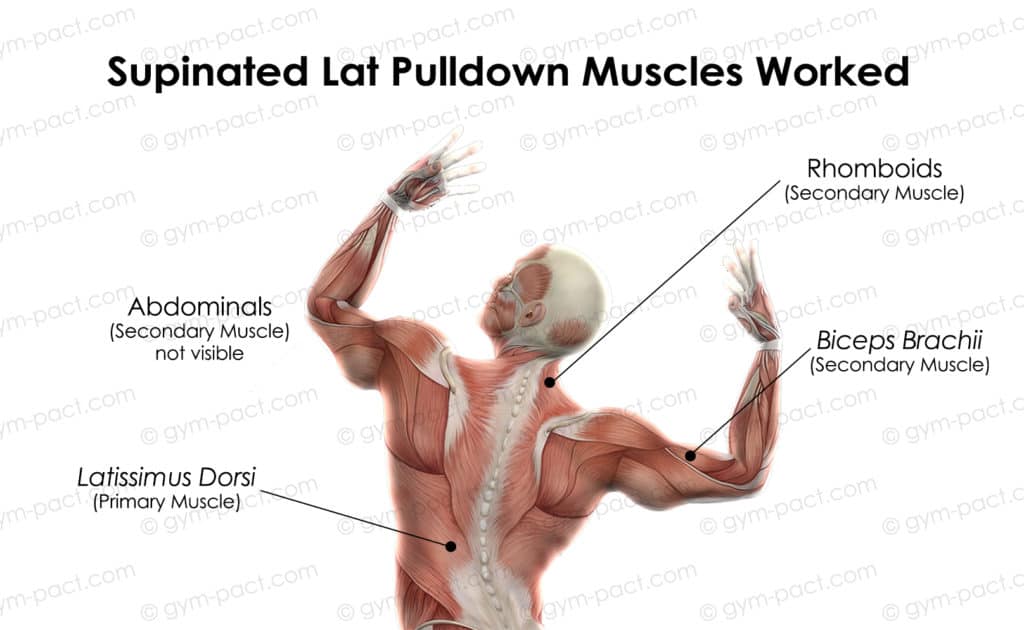When it comes to building and strengthening the muscles in your back, there are few exercises that can hold a candle to the supinated lat pulldown. By performing a pulldown with a supinated grip – sometimes referred to as an underhand grip – you are also engaging some of the muscles in your arms.
Given its wide-ranging impact on your upper body, the supinated lat pulldown is a regular part of many weight training programs. It is undoubtedly one of the more popular upper body training exercises for those looking to get the most out of their workouts.
If you want to find out more about how to perform the supinated lat pulldown correctly, which muscles it works and what variations you can perform, then read on.
Benefits of The Supinated Lat Pulldown
What makes the supinated lat pulldown (sometimes referred to as a reverse grip pulldown) such a captivating exercise is the impact it can have on your quality of life. We will detail below specifically which muscles this movement targets, but this pulldown primarily engages your back muscles.
Related Post: Reverse Grip Tricep Pushdown Exercise Guide
In doing so, it is strengthening and activating muscle groups that tend to suffer from muscle imbalances; that is, these muscles are usually weaker than their opposite counterparts (the chest and core). This mainly affects those who sit at a desk for prolonged periods of time, causing poor posture.
The reverse grip pulldown helps to reestablish muscle balance in your upper body and improve your overall posture, which can reduce pain and discomfort. This can also have significant psychological effects by increasing your confidence and self-esteem.
The supinated grip pulldown also has advantages over other types of pulldown, as it allows you to pull the bar down lower. The pronated grip pulldown – or overhand grip pulldown – has a more limited range of movement, for example.
So, you can actually work your latissimus dorsi muscles harder with the supinated grip pulldown because you are increasing the time under tension and producing more force to bring the bar lower.
Muscles worked

The primary muscles activated in this exercise are your latissimus dorsi, or lats, which can be identified as the fan-shaped muscle on either side of your back. This is also the broadest muscle of the back, making each one an important focus of weight training.
Latissimus dorsi weight training is, therefore, a very popular choice for many people as it can add serious size and definition to your upper body.
The secondary muscle groups involved in the supinated lat pulldown are found in your arms and your biceps muscle, or biceps brachii, are fully contracting as well, though your back should still be doing most of the work.
Your abdominal muscles will become engaged to keep your upper body stable while other muscles in your upper back, such as the rhomboids muscle, will also be activated during the pulldown.
How to Perform the Supinated Lat Pulldown
- Sit on a flat bench in front of the cable machine, facing toward it. Sit with a strong posture and your spine neutral.
- Reach up with both arms and take hold of the bar with an underhand grip (palms facing toward you), with your hands roughly shoulder-width apart. Your arms should also be almost fully extended, with a slight bend in your elbows.
- Pull the bar down toward you until it goes beyond your upper chest and reaches the top of your rib cage. Hold for a moment.
- Extend your arms back up and return the bar to the starting position. Repeat for 12-15 reps.
Tips
- Lean back slightly during the movement to take some of the strain away from your lower back and to promote rhomboid muscle activity.
- Grip widths are important. You want roughly a medium grip on the bar – a narrow grip pulldown will mean your lats are working less, while a wider grip will limit your range of movement and compromise the exercise. A wide grip pulldown should be performed with a pronated grip. Never underestimate the influence of grip width!
- With your medium grip, keep your elbows in line with your hands during the exercise, and try not to let them flare out to the side.
- The reverse grip position will encourage biceps brachii muscle activity, but remember that your lats are the primary movers here, so focus on contracting them at the bottom of the movement and ensure they are dictating the pulling motion.
- Your shoulder blades should naturally move down and back as you pull the bar down, and then flow in the opposite direction when it rises back up.
Mistakes to avoid
- Other back exercises encourage you to pinch your shoulder blades together, but you want to avoid doing so during the supinated lat pulldown.
- Your back is a powerful part of your body but avoid the temptation to complete pulldowns until muscle failure. This can lead to injury and back pain.
- When using a full bar on a cable machine, do not use a one-handed grip as this increases the risk of injury.
- If you feel any pain in your shoulder joint, do not continue with the exercise. This isn’t the place to test the limits of shoulder stability.
- Avoid using a heavier weight when first starting out with the underhand grip pulldown, particularly if you don’t have much weight training experience. Start out with an average weight, or a light one, and perfect your form before adding resistance.
Supinated Lat Pulldown Variations
One of the most common variations to the reverse grip lat pulldown is the pronated (overhand) grip pulldown. This is a wide grip pulldown and features a similar range of motion, except that you are not pulling the bar as low and your shoulder blades will contract more.
The wide grip lat pulldown will still target your lats but it does not recruit as many of the arm muscles, in particular your biceps.
Narrow grip pulldowns, however, will activate your biceps brachii even more than the supinated grip pulldown and are closer to a traditional bicep curl in that sense.
The muscle activation levels are largely the same across these different variations and depend more on the resistance and weight used, rather than grip orientation. However, where and how you place your hands will determine which muscle groups are activated, and this is where the influence of exercise variations comes into play.
The Bottom Line
The supinated grip lat pulldown exercise is arguably the most versatile pulldown variation as it not only targets your lats but also your arms, including the triceps muscle. The risk of injury is relatively low unlike, say, shoulder press exercises that can damage your shoulder girdle.
With the correct form and a consistent training schedule, this pulldown will also help improve your posture and tackle muscle imbalances in your upper body.
Related: Lat Pulldown Alternatives: 12 Of The Best Alternate Exercises
Frequently Asked Questions
What is the antagonist muscle in a lat pulldown?
The deltoid. As your lats contract to perform the movement, your deltoids lengthen and relax to allow for optimal shoulder movement.
Which grip is best for lat pulldown?
This depends on your goals and what muscles you want to target the most. A supinated grip will activate your biceps while a pronated grip will work your upper back more. It can also be a question of preference, and using the grip that feels best for you; all of them will still be working your lats, after all.



